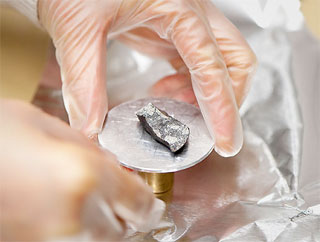Secrets of Wisconsin meteorite revealed
As Russian scientists scramble to collect and analyze the remains of the historic meteorite that injured an estimated 1,200 people in Chelyabinsk on Feb. 15, scientists in Wisconsin are set to publish their analysis of a smaller meteorite that struck southwest Wisconsin on April 14, 2010.

Valley
The Mifflin meteorite created a fireball equivalent to 20 tons of TNT, initiating a scientific quest that revealed the complex history of a rocky body that predates Earth’s formation.
Although the fireball could be seen from Madison, 50 miles away, the meteorite was far smaller than the object that exploded over Siberia.
In Wisconsin, about eight pounds of fragments were recovered from an object that probably weighed a few tons before it struck the atmosphere, says John Valley, a professor of geoscience at UW–Madison. “It was a gold rush for about a week, like the Wild West, as residents and meteorite hunters from around the world scoured the area.”
Although fragments could be sold to collectors, “many Wisconsinites were generous enough to donate and allow us to analyze the samples they collected,” says Valley. Using a variety of sophisticated instruments located at the Department of Geoscience and other labs in the United States, Switzerland and Italy, the scientists identified the stony meteorite as an L5 chondrite.
Three high-precision instruments at UW–Madison contributed to the analysis:
— a scanning electron microscope produced detailed images of the samples;
— an electron microprobe analyzed the chemical composition of spots just three-thousandths of a millimeter in diameter; and
— a mass spectrometer measured the ratio of oxygen isotopes, essential to understanding the geologic history.

Noriko Kita, a meteorite expert at UW–Madison, examines a piece of rock believed to be from the April 14, 2010 meteor that showered the night sky over Southwestern Wisconsin.
Photo: Jeff Miller
Valley says the L5 chondrites, one of the most common types of meteorite, apparently all descended from one astronomical body that coalesced in the solar system 4.56 billion years ago, even before the Earth came together from the primordial dust that formed the rocky inner planets.
Much later, about 470 million years ago, “the parent asteroid of L chondrites was destroyed, probably by a large impact with another body,” says Valley.
The evidence for that impact is written in the fragments, says first author Noriko Kita, a meteorite specialist on campus. “We see signs of heavy shock and heating from the geochemistry. In fact, there is evidence for multiple impact and fragmentation events.“
The resulting structure would be called breccia if found on Earth, adds Kita. “Breccia implies shattering, followed by heating, that bonded it back together. Breccia is also seen in impact craters on the moon.”
Close examination shows a meteorite that “is like a Russian doll,” says Valley. “At each scale of magnification, you see something new and interesting. Then if you zoom in, you see more detail, and different structures. We’ve looked at several levels of magnification, and each one is fascinating.”
“At each scale of magnification, you see something new and interesting. Then if you zoom in, you see more detail, and different structures. We’ve looked at several levels of magnification, and each one is fascinating.”
John Valley
The surface of the meteorite was altered as atmospheric friction heated it during the last seconds of its descent to Earth, says Valley. “This black fusion crust was created by temperatures above the rock’s melting point, at least 1,200 degrees Celsius (about 2,000 degrees Fahrenheit), and possibly way above that. In some of the Mifflin samples, the surface melted enough that glass was formed, and you can even see drips.”
The study will be published in a future issue of the journal Meteoritics and Planetary Science. Eight fragments from the Mifflin meteorite, plus five fragments from other meteorites that struck Wisconsin, are on display at the UW–Madison Geology Museum in Weeks Hall, 1215 Dayton St., Madison.
Impacts like the one in Russia are extremely rare on a human time-scale, but about 470 million years ago, just after the collision recorded by Mifflin, Earth was bombarded by L chondrites. “There are limestone quarries where black rocks can be seen in the white limestone,” Valley says. “These are meteorites, and we can date their arrival to 470 million years ago. We never find them older than 470 million years, and after about 10 million years, they become rare.”
It’s possible that the rocks that struck Grant and Iowa County in 2010 came from the same parent body as a meteorite that apparently struck Pierce County more than 450 million years ago, Valley says, creating a four-mile diameter feature called the Rock Elm Complex.
As the Russian meteorite shows, these samples from space “always attract attention,” says Kita, who with Valley and others at the UW will continue to study these fascinating messengers from another world.



